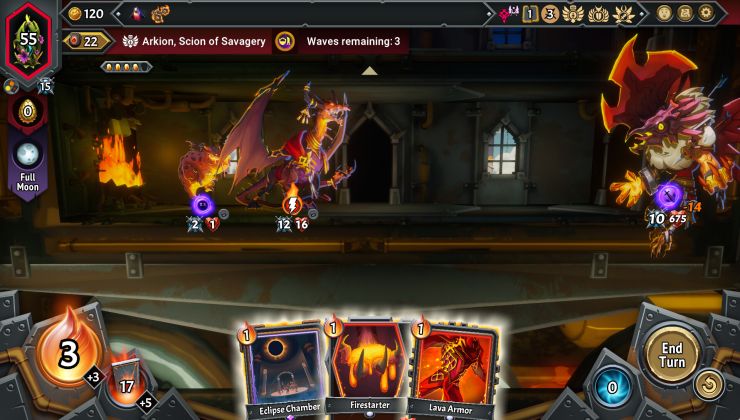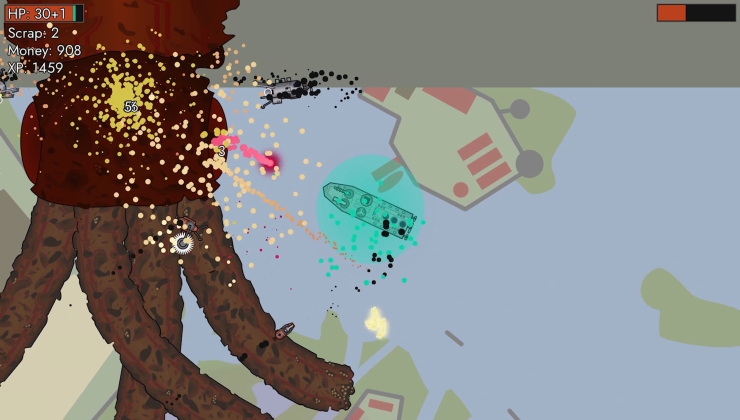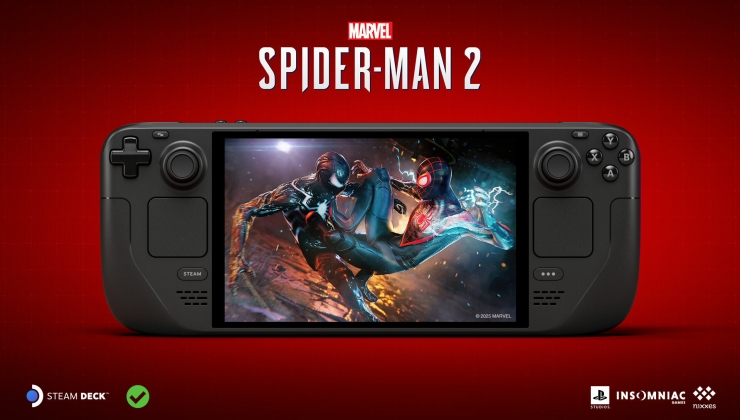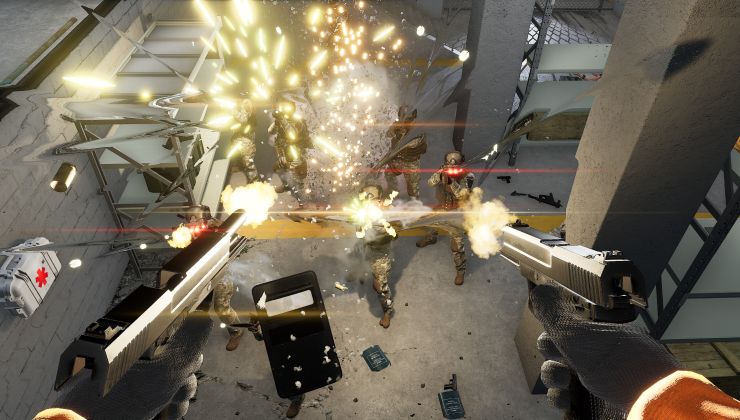After the rather exciting development in the last Steam Hardware & Software Survey where Linux users overtook macOS for the first time, the latest survey shows Linux continues to be above macOS but with the numbers dipping down.
The latest results for August 2023:
- Windows 96.61% + 0.40%
- Linux 1.82% - 0.14%
- OSX 1.57% - 0.27%
When switching over to the Linux-only data here’s the most popular distributions for gaming on Steam:
- SteamOS Holo 64 bit 44.18% +2.11%
- "Arch Linux" 64 bit 7.68% -0.26%
- Freedesktop.org SDK 22.08 (Flatpak runtime) 64 bit 6.03% +0.04%
- Ubuntu 22.04.2 LTS 64 bit 4.10% -3.28%
- Manjaro Linux 64 bit 3.99% -0.30%
- Linux Mint 21.2 64 bit 3.41% +3.41%
- Pop!_OS 22.04 LTS 64 bit 2.93% -0.04%
- Ubuntu 22.04.3 LTS 64 bit 2.91% +2.91%
- Other 24.78% -0.74%
So we continue to see that the Steam Deck with SteamOS is what's really pushing Linux gaming right now with it growing again this month compared to other distributions.
As usual the trends can be seen on our Steam Tracker.
Some you may have missed, popular articles from the last month:
All posts need to follow our rules. For users logged in: please hit the Report Flag icon on any post that breaks the rules or contains illegal / harmful content. Guest readers can email us for any issues.
Did you fetch all of that manually from the website? It sometimes took like half a minute for it to display the link(s) for a certain day for me...
I did. I've done data hunting for Liam's tracker before. The trick is to load the results into new tabs so that they can be getting on with loading while you wait for the next link to appear. And to make a cup of tea if it's getting too tedious, of course.
I was opening in tabs as well... but I don't drink tea, so obviously, I couldn't do all of it.
Ah, on the semi-serious side: Where would the trend lines meet?
Last edited by Eike on 4 Sep 2023 at 6:53 pm UTC
1 Likes, Who?
I was opening in tabs as well... but I don't drink tea, so obviously, I couldn't do all of it.
Ah, yeah, that's the issue: not enough tea.
Ah, on the semi-serious side: Where would the trend lines meet?
May 2025, I think?
2 Likes, Who?
Timeline starts with Mantle which presented such ideas before Apple and MS rushed to make NIH knock offs of them. And AMD from the beginning expressed the interest to make it a common API. That's why Mantle later was turned into Vulkan. Basically, collaboration on it could have started from the beginning, if Apple and MS weren't arrogant lock-in proponents who benefit from work of others either way.Mantle is omitted since it's the starting point for all APIs. AMD themselves provided Microsoft on everything about Mantle to develop Direct3D 12. They don't really cared about an open API, they cared about an API which would boost their GPUs.
Your timeline is faulty, Vulkan was first announced in July 2014 at the SIGGRAPH conference. And ofc development had been quicker if say Apple and Microsoft had decided to join the development, one cannot just ignore the massive amount of money and resources that those two have compared with Khronos.Yes, I missed the date. But they didn't announce Vulkan, they announced that work on the next API started. A month after Apple released Metal. Khronos also has a bad history about API announcements (remember Long Peaks?).
According to some (random) opinions, Metal seems to be a just different API and easier to use than Vulkan. It's probably more of a OpenGL replacement than Vulkan, but I can't say much about that. But we know that Vulkan is hard to use.
Also I don't see why waiting would have been such a problem, the first wave of games released with Metal came in 2017 anyway since everyone waited to see it stabilize first.Can you provide a source when it was first used on iOS? Metal started on iOS where performance is much more limited. The impact of OpenGL/driver overhead is much bigger.
0 Likes
Timeline starts with Mantle which presented such ideas before Apple and MS rushed to make NIH knock offs of them. And AMD from the beginning expressed the interest to make it a common API. That's why Mantle later was turned into Vulkan. Basically, collaboration on it could have started from the beginning, if Apple and MS weren't arrogant lock-in proponents who benefit from work of others either way.Mantle is omitted since it's the starting point for all APIs. AMD themselves provided Microsoft on everything about Mantle to develop Direct3D 12. They don't really cared about an open API, they cared about an API which would boost their GPUs.
Your timeline is faulty, Vulkan was first announced in July 2014 at the SIGGRAPH conference. And ofc development had been quicker if say Apple and Microsoft had decided to join the development, one cannot just ignore the massive amount of money and resources that those two have compared with Khronos.Yes, I missed the date. But they didn't announce Vulkan, they announced that work on the next API started. A month after Apple released Metal. Khronos also has a bad history about API announcements (remember Long Peaks?).
According to some (random) opinions, Metal seems to be a just different API and easier to use than Vulkan. It's probably more of a OpenGL replacement than Vulkan, but I can't say much about that. But we know that Vulkan is hard to use.
Also I don't see why waiting would have been such a problem, the first wave of games released with Metal came in 2017 anyway since everyone waited to see it stabilize first.Can you provide a source when it was first used on iOS? Metal started on iOS where performance is much more limited. The impact of OpenGL/driver overhead is much bigger.
No I have no data regarding iOS usage, Android works quite well with OpenGL ES though so I see no reason why the iPad could not have done that aswell. To me Metal is just too much NIH and an attempt to perform vendor lock-in on primarily iOS.
What I did find however was on the Wiki on Metal that Apple announced in 2017 that 148k apps used Metal which is only 9% of the number of apps they have in their app store, so it wasn't like people where rushing out to implement it.
0 Likes
What I did find however was on the Wiki on Metal that Apple announced in 2017 that 148k apps used Metal which is only 9% of the number of apps they have in their app store, so it wasn't like people where rushing out to implement it.
I'm not sure this is a useful percentage. Most apps don't need any 3D API in the first place, right?
0 Likes
No I have no data regarding iOS usage, Android works quite well with OpenGL ES though so I see no reason why the iPad could not have done that aswell. To me Metal is just too much NIH and an attempt to perform vendor lock-in on primarily iOS.That's like saying Vulkan is redundant. OpenGL ES is just subset of OpenGL, it retains the flaws of the API.
What I did find however was on the Wiki on Metal that Apple announced in 2017 that 148k apps used Metal which is only 9% of the number of apps they have in their app store, so it wasn't like people where rushing out to implement it.I haven't found concrete numbers, but there are estimates of the available games in the app store: 200,000-800,000. Even taking 800,000 as an estimate (which is unlikely when, 2022 were only 1,783,232 apps in the store, this number comes from Apple) 148,000 would be quite good.
According to Apple, more than 148,000 applications use Metal directly, and 1.7 million use it through high-level frameworks, as of June 2017It's not limited to games but internally used everywhere.
0 Likes
What I did find however was on the Wiki on Metal that Apple announced in 2017 that 148k apps used Metal which is only 9% of the number of apps they have in their app store, so it wasn't like people where rushing out to implement it.
I'm not sure this is a useful percentage. Most apps don't need any 3D API in the first place, right?
Which kinda is on point no?
0 Likes
No I have no data regarding iOS usage, Android works quite well with OpenGL ES though so I see no reason why the iPad could not have done that aswell. To me Metal is just too much NIH and an attempt to perform vendor lock-in on primarily iOS.That's like saying Vulkan is redundant. OpenGL ES is just subset of OpenGL, it retains the flaws of the API.
No, no one is saying that Metal isn't better than OpenGL or OpenGL ES. The point is that Metal wasn't that much better than OpenGL or OpenGL ES that Apple had to go full on NIH and further fragment the graphics API market, _unless_ they ofc wanted to ride the wave of vendor lock-in.
What I did find however was on the Wiki on Metal that Apple announced in 2017 that 148k apps used Metal which is only 9% of the number of apps they have in their app store, so it wasn't like people where rushing out to implement it.I haven't found concrete numbers, but there are estimates of the available games in the app store: 200,000-800,000. Even taking 800,000 as an estimate (which is unlikely when, 2022 were only 1,783,232 apps in the store, this number comes from Apple) 148,000 would be quite good.
According to Apple, more than 148,000 applications use Metal directly, and 1.7 million use it through high-level frameworks, as of June 2017It's not limited to games but internally used everywhere.
Yes and that makes it the 9% I wrote earlier. The point being that even 3 full years after the introduction 91% of app-makers still though that OpenGL ES was good enough which means that iOS didn't gain any major benefits over Android by implementing Metal. So that closes the door on "Apple was forced to implement Metal or iOS would be obsolete" that some people throw around (note that I don't accuse you of doing that, the same discussion is happening on Phoronix at the moment).
So Apple didn't _need_ Metal, they could have waited for Vulkan just like Google did. And hadn't they been so hell bent on NIH and vendor lock-in they could have spear-headed the collaborative project to replace OpenGL with a new better API, and that by all means could have been Metal.
1 Likes, Who?
No, no one is saying that Metal isn't better than OpenGL or OpenGL ES. The point is that Metal wasn't that much better than OpenGL or OpenGL ES […]Says who? The difference between Metal & OpenGL are the same as Vulkan & OpenGL (potentially immense). Metal is just easier to use than Vulkan (according to developers comparing both).
Yes and that makes it the 9% I wrote earlier. The point being that even 3 full years after the introduction 91% of app-makers still though that OpenGL ES was good enough which means that iOS didn't gain any major benefits over Android by implementing Metal. So that closes the door on "Apple was forced to implement Metal or iOS would be obsolete" that some people throw around (note that I don't accuse you of doing that, the same discussion is happening on Phoronix at the moment).I don't get what you're calculating.
Most applications don't use any graphics library, usage is abstracted by the system. That's true for all systems, therefore already 1,7 million apps were using Metal (probably almost all).
The 9% (of all apps) must be compared to the apps that are directly using a graphics library, e.g. games. Since we don't have any numbers on that, we can only guess.
An estimate is the number of games, that's 11% (200,000) to 47% (800,000) (of all apps). So in the best case scenario 74% of all games already used Metal. Unlikely, but the adaptation would still be quite good, much better than Direct3D 12 let alone Vulkan on PC (I didn't find anything on Android).
Metal is not limited to apps. Metal is Apple's graphics API, they're using it across the whole system. Waiting another 2 or 3 years makes a huge difference for them. It's not only about performance but also efficiency, let alone developer experience.
So Apple didn't _need_ Metal, they could have waited for Vulkan just like Google did. And hadn't they been so hell bent on NIH and vendor lock-in they could have spear-headed the collaborative project to replace OpenGL with a new better API, and that by all means could have been Metal.Obviously they want to & actually control everything on their systems (from hardware to software). But waiting makes a huge difference. They release each year a new generation of hardware which is restricted by size, power & heat. In the best case scenario, Metal was like a new GPU generation, just by software.
To answer this question: The first Metal based game was released in 2014 (https://www.pocket-lint.com/games/news/131021-asphalt-8-airborne-is-first-metal-ready-game-for-ios-8-and-boy-does-it-look-lovely/)
But think whatever you want. I know you're wrong & I've done enough to try convince you.
0 Likes
And Vulkan isn't that much better than OpenGL ES on a mobile either unless we talk really graphically intensive games and then mobile and iOS isn't the platform for that anyway nor is macOS, and even then Vulkan/Metal is not always better than OpenGL (you have to be very thread dependent for Vulkan/Metal to be much better).No, no one is saying that Metal isn't better than OpenGL or OpenGL ES. The point is that Metal wasn't that much better than OpenGL or OpenGL ES […]Says who? The difference between Metal & OpenGL are the same as Vulkan & OpenGL (potentially immense). Metal is just easier to use than Vulkan (according to developers comparing both).
9% where the ones using Metal directly and is Apples own numbers. And that most applications don't use any graphics library is kinda the point in showing that the "desperate need" for Metal wasn't and isn't really there.Yes and that makes it the 9% I wrote earlier. The point being that even 3 full years after the introduction 91% of app-makers still though that OpenGL ES was good enough which means that iOS didn't gain any major benefits over Android by implementing Metal. So that closes the door on "Apple was forced to implement Metal or iOS would be obsolete" that some people throw around (note that I don't accuse you of doing that, the same discussion is happening on Phoronix at the moment).I don't get what you're calculating.
Most applications don't use any graphics library, usage is abstracted by the system. That's true for all systems, therefore already 1,7 million apps were using Metal (probably almost all).
The 9% (of all apps) must be compared to the apps that are directly using a graphics library, e.g. games. Since we don't have any numbers on that, we can only guess.
So Apple didn't _need_ Metal, they could have waited for Vulkan just like Google did. And hadn't they been so hell bent on NIH and vendor lock-in they could have spear-headed the collaborative project to replace OpenGL with a new better API, and that by all means could have been Metal.Obviously they want to & actually control everything on their systems (from hardware to software). But waiting makes a huge difference. They release each year a new generation of hardware which is restricted by size, power & heat. In the best case scenario, Metal was like a new GPU generation, just by software.
To answer this question: The first Metal based game was released in 2014 (https://www.pocket-lint.com/games/news/131021-asphalt-8-airborne-is-first-metal-ready-game-for-ios-8-and-boy-does-it-look-lovely/)
But think whatever you want. I know you're wrong & I've done enough to try convince you.
No you haven't, you have not provided a single argument for why Apple was in such a desperate need of Metal vs just using OpenGL ES until Vulkan came or launching a collab for a open replacement of OpenGL outside of NIH and vendor lock-in.
Every single mobile manufacturer releases each year a new generation of hardware and they are all restricted in size, power & heat, none of this is Apple specific problems, so that is not an argument either.
Last edited by F.Ultra on 7 Sep 2023 at 11:38 pm UTC
1 Likes, Who?
Mantle is omitted since it's the starting point for all APIs.That's exactly the point. Obviously AMD wanted to have one common API, not multiple NIHs. So why did MS and Apple have to rush making theirs? They could work with AMD and then Khronos on the common one.
2 Likes, Who?
That's exactly the point. Obviously AMD wanted to have one common API, not multiple NIHs. So why did MS and Apple have to rush making theirs? They could work with AMD and then Khronos on the common one.If that was the case, they wouldn't have provided Microsoft with everyrhing on Mantle, but they did.
0 Likes
That's exactly the point. Obviously AMD wanted to have one common API, not multiple NIHs. So why did MS and Apple have to rush making theirs? They could work with AMD and then Khronos on the common one.If that was the case, they wouldn't have provided Microsoft with everyrhing on Mantle, but they did.
They provided everyone with everything. Their whole API was opened for anyone who wanted. The goal was to encourage collaboration, which indeed happened when enough people got together to make Vulkan from it. But not MS and Apple. They just exploited it to make their own NIHs becasue they could. It tells you everything there is to tell about their approach.
2 Likes, Who?
What I did find however was on the Wiki on Metal that Apple announced in 2017 that 148k apps used Metal which is only 9% of the number of apps they have in their app store, so it wasn't like people where rushing out to implement it.
I'm not sure this is a useful percentage. Most apps don't need any 3D API in the first place, right?
Which kinda is on point no?
One of us has a big misunderstanding here. :D Let's find out who.
You said "only 9% of the number of apps they have in their app store" have been using Metal. My point is that this might(!) be 100% of the apps needing a low-level 3D API in the first place. So we can't conclude "it wasn't like people where rushing out to implement it".
0 Likes
They provided everyone with everything. Their whole API was opened for anyone who wanted. The goal was to encourage collaboration, which indeed happened when enough people got together to make Vulkan from it. But not MS and Apple. They just exploited it to make their own NIHs becasue they could. It tells you everything there is to tell about their approach.
AMD disagrees with you, in Feb 2015:
[https://gamingbolt.com/the-big-interview-amds-robert-hallock-on-mantle-directx-12-ps4xbox-one-free-sync-and-more](https://gamingbolt.com/the-big-interview-amds-robert-hallock-on-mantle-directx-12-ps4xbox-one-free-sync-and-more)
Rashid Sayed: Switching back to Mantle once again, Intel had approached for access to API. Is there any progress on that front?
Robert Hallock: Other IHVs will receive access when we exit beta and make the API public for download. Any IHV will be able to create a Mantle solution for themselves, and it is on them to decide whether or not they want to catch up to AMD in the area of low-overhead, high-throughput and incredibly efficient graphics workloads. At this time, though, Mantle is still being privately developed by AMD and nearly 100 ISVs.
[Mantle FAQ](https://web.archive.org/web/20180109075745/http://support.amd.com/en-us/kb-articles/Pages/mantle-faq.aspx)
What are the similarities between Mantle and DirectX® 12?
DirectX® 12 is Microsoft’s own creation, though its development has been steered by input from many different technology partners including AMD. We have welcomed the same input on Mantle by sharing the full specification with Microsoft since the early days of our API. As the industry moves to embrace the principles of “closer-to-the-metal” API design, it is evident that our pioneering work with this concept has been highly influential.
But here, too: That's enough for me.
0 Likes
AMD disagrees with you, in Feb 2015:
[https://gamingbolt.com/the-big-interview-amds-robert-hallock-on-mantle-directx-12-ps4xbox-one-free-sync-and-more](https://gamingbolt.com/the-big-interview-amds-robert-hallock-on-mantle-directx-12-ps4xbox-one-free-sync-and-more)
I don't see any disagreement. AMD wanted their API to be used by MS - so what. They wanted it to be used by everyone else too.
And they are MS partner for consoles. Obviously if MS started pushing their NIH AMD won't be trying to stop them. It was MS idea, not AMD's.
Last edited by Shmerl on 8 Sep 2023 at 3:23 pm UTC
1 Likes, Who?
What I did find however was on the Wiki on Metal that Apple announced in 2017 that 148k apps used Metal which is only 9% of the number of apps they have in their app store, so it wasn't like people where rushing out to implement it.
I'm not sure this is a useful percentage. Most apps don't need any 3D API in the first place, right?
Which kinda is on point no?
One of us has a big misunderstanding here. :D Let's find out who.
You said "only 9% of the number of apps they have in their app store" have been using Metal. My point is that this might(!) be 100% of the apps needing a low-level 3D API in the first place. So we can't conclude "it wasn't like people where rushing out to implement it".
That "most apps don't need any 3D API in the first place" is exactly my point. It means that they went through all this trouble fragmenting the graphics API scene only to cater to 9% of apps (and most likely only a subset of those apps really benefits meaning that the real number is lower).
0 Likes









 How to set, change and reset your SteamOS / Steam Deck desktop sudo password
How to set, change and reset your SteamOS / Steam Deck desktop sudo password How to set up Decky Loader on Steam Deck / SteamOS for easy plugins
How to set up Decky Loader on Steam Deck / SteamOS for easy plugins
See more from me